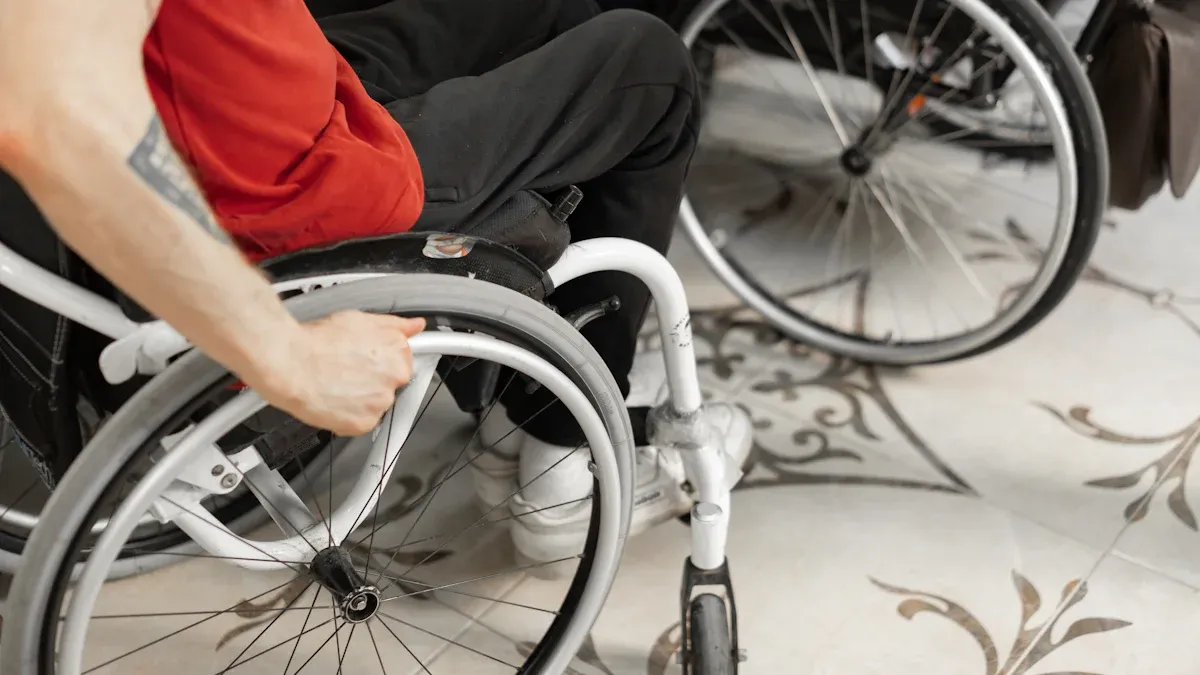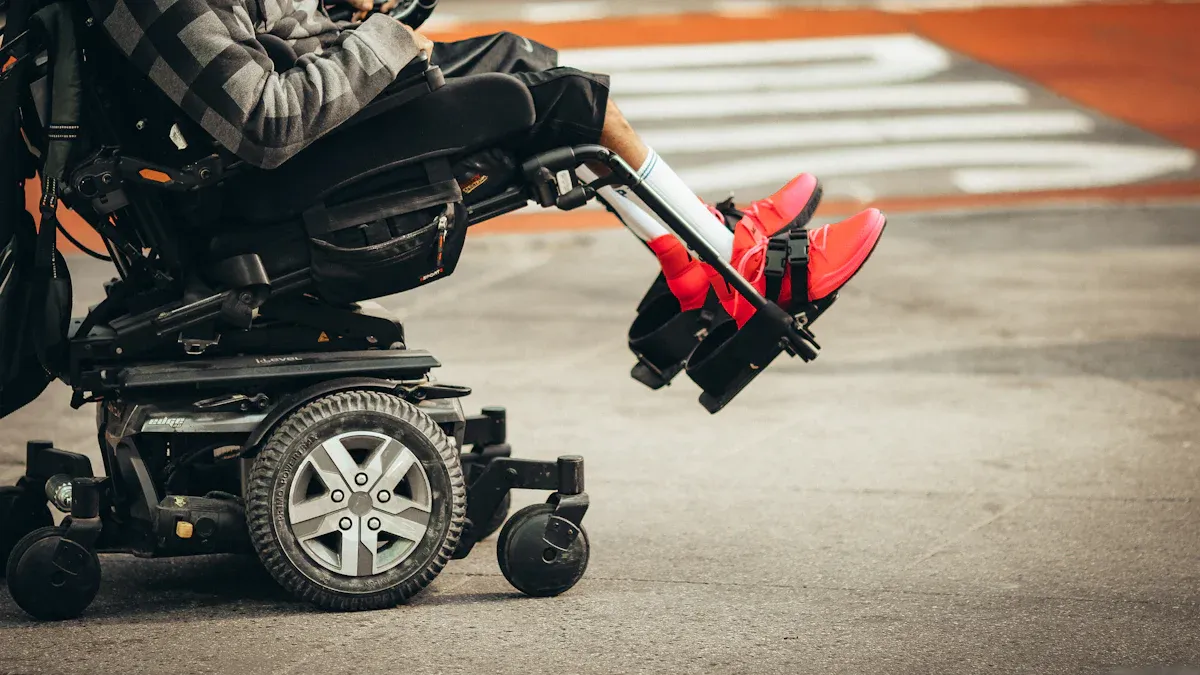
Choosing the right electric wheel chair truly changes lives. Many people now consider options like a power chair or a lightweight electric wheelchair for enhanced mobility. The motorized wheelchair market continues to grow as more users seek comfort and independence. Some prefer a foldable power wheelchair for easy travel, while others appreciate more traditional designs.
Key Takeaways
- Choose a wheelchair that matches your physical strength to avoid pain and injury; electric wheelchairs help if pushing a manual chair feels tiring.
- Consider your daily activities and travel needs; manual chairs suit short trips and indoor use, while electric chairs save energy for longer distances and busy lifestyles.
- Think about independence and support; electric wheelchairs often offer more freedom and reduce the need for help, improving confidence and comfort.
Deciding Between Manual and Electric Wheel Chair

Physical Abilities and Strength
Physical strength plays a big role in choosing between a manual wheelchair and an electric wheel chair. Some people have strong arms and good balance. They can push a manual wheelchair for long periods. Others may have weak muscles or joint pain. For them, using a manual wheelchair can cause shoulder strain or even injury.
Researchers have studied how muscle strength affects wheelchair use. They built models to see how different designs change the load on muscles like the triceps and shoulders. Smaller wheels and certain axle positions make pushing harder. People with less strength feel more muscle strain. Lowering the axle can help reduce this burden. This means that wheelchair design should match a person’s physical abilities to prevent injuries and improve comfort.
Tip: If pushing a manual wheelchair feels tiring or painful, an electric wheel chair might be a better fit. It moves with a joystick or buttons, so users do not need strong arms.
Lifestyle and Daily Routines
Everyone has a different daily routine. Some people travel long distances, go to work, or run errands every day. Others spend most of their time at home. A manual wheelchair works well for short trips or indoor use. It is easy to move in tight spaces and does not need charging.
Long-term studies show that tracking daily routines helps people stay healthy. For example, a 12-week study used a special app and fitness tracker to watch wheelchair users’ activity, sleep, and nutrition. The app gave feedback and helped users make healthy choices. Even though the study did not compare manual and electric wheelchairs directly, it showed that daily routines matter. People who move around a lot or need to travel far may find an electric wheel chair more helpful. It saves energy and makes it easier to go longer distances without getting tired.
- Manual wheelchairs: Best for short trips, indoor use, and people with active upper bodies.
- Electric wheel chair: Great for busy lifestyles, outdoor travel, and those who want to save energy.
Independence and Support Needs
Independence means being able to do things on your own. Some people need help only sometimes, while others need support all the time. Studies show that many wheelchair users have different levels of independence. Age, health, and even where someone lives can affect how much help they need.
A survey in Canada found that over 288,000 people use wheelchairs or scooters for daily life. Some need help only for certain tasks. Others need full-time support. The survey also found that funding often covers just one device, which may not meet all needs. People who want more independence often choose an electric wheel chair. It lets them move around without asking for help. Manual wheelchairs can limit independence if the user gets tired or cannot push for long.
| Factor | Manual Wheelchair | Electric Wheel Chair |
|---|---|---|
| Independence Level | May need help on slopes or long trips | More self-reliant, less need for assistance |
| Support Needs | Higher for some users | Lower for most users |
Budget and Long-Term Costs
Money is always a big factor. Manual wheelchairs usually cost less at first. They are simple and need little maintenance. Electric wheel chairs cost more to buy. They also need battery charging and sometimes repairs. Over time, the cost of batteries and parts can add up.
But there is more to think about than just the price tag. Manual wheelchairs are easier to transport and fix. Electric wheel chairs offer more comfort and features, like reclining seats or tilt functions. These features can help prevent pressure sores and make daily life easier. Some insurance plans or funding programs may help pay for either type, but often only one device is covered.
Note: Think about both the upfront cost and the long-term expenses. Consider how much independence and comfort matter to you.
- Manual wheelchair: Lower cost, less maintenance, but may need more physical effort.
- Electric wheel chair: Higher cost, more features, and less physical strain.
Manual Wheelchairs: Pros and Cons
Advantages of Manual Wheelchairs
Manual wheelchairs offer several clear benefits. Many people like them because they are lightweight and easy to move. Users can fold most manual wheelchairs, making travel and storage simple. These chairs do not need batteries or charging, so users never worry about running out of power.
Research shows that the right tire type and pressure make a big difference. Pneumatic tires with good air pressure help the chair roll smoothly and reduce the effort needed to push. Larger caster wheels also make movement easier. When users keep their wheelchairs well-maintained, they notice less rolling resistance. This means they use less energy and protect their arms and shoulders from strain.
A well-fitted manual wheelchair supports good posture and comfort. Experts say that tuning the chair to match the user’s body helps prevent injuries and keeps people moving longer. Many users enjoy the freedom to move at their own pace and stay active.
Tip: Regular maintenance and the right setup can make a manual wheelchair much easier to use every day.
Limitations of Manual Wheelchairs
Manual wheelchairs do have some drawbacks. Users need enough upper body strength to push themselves, especially over long distances or up hills. If someone has weak arms or joint pain, using a manual chair can cause discomfort or even injury.
Some people find that pushing a manual wheelchair for long periods leads to tired muscles. Without proper ergonomic adjustments, users risk overuse injuries in their shoulders and wrists. Manual wheelchairs may not work well on rough terrain or steep slopes.
Manual wheelchairs also require regular care. Tires need checking, and parts may need fixing. If users skip maintenance, the chair can become harder to push and less safe. For those who want to travel far or need extra support, a manual wheelchair might not meet all their needs.
Electric Wheel Chair: Pros and Cons

Benefits of Electric Wheel Chair
An electric wheel chair can make life easier for many people. It helps users move around with less effort. People who have weak arms or get tired easily find it helpful. They can travel longer distances and do more things on their own. Many users say they feel more confident and safe when using an electric wheel chair. Some models even have smart features like anti-collision systems. These features help older adults or people with cognitive challenges avoid accidents and feel more secure.
Studies show that people who use power wheelchairs often join more activities and visit more places. They report higher confidence and better skills in using their chairs. This leads to a bigger life-space and more chances to meet friends or go out. For those who need extra help with safety or independence, an electric wheel chair can be a great choice.
Tip: Electric wheel chairs can boost social life and make daily routines easier for people with different needs.
Drawbacks of Electric Wheel Chair
Electric wheel chairs also have some downsides. They cost more than manual chairs and need regular charging. Repairs and battery replacements can add to the expense. Some models are heavy and hard to fit in small cars or tight spaces. Not every building or sidewalk is easy to access with a larger chair.
People may need help with maintenance or moving the chair if it breaks down. Sometimes, insurance or funding only covers one type of chair, so users must choose carefully. Even with these challenges, many people feel the benefits outweigh the drawbacks, especially if they value independence and comfort.
Quick Comparison Checklist
Assess Your Needs
Choosing the right wheelchair starts with a good look at daily life and personal goals. Many experts recommend using structured assessment tools to guide this process. These tools often include interviews about lifestyle, physical assessments for body measurements, and questions about the home or work environment. Some forms, like the Basic Wheelchair Assessment Form, help gather details about mobility and postural support. Others, such as the Intermediate Wheelchair Assessment Form, focus on matching wheelchair features to daily activities.
- Assessment interviews ask about routines, places visited, and support needed.
- Physical assessments check body size and shape for a comfortable fit.
- Wheelchair skills assessments test how well someone can use the chair safely.
- Environment checks look at doorways, ramps, and outdoor spaces.
A checklist like this helps match the right wheelchair to each person’s needs. It also makes sure the chair fits well and supports independence.
Make Your Choice
After gathering all the facts, it’s time to weigh the options. Some people want a lightweight manual chair for easy travel. Others need an Electric Wheel Chair for longer trips or less arm strain. Safety matters, too. Studies show that even with advanced features like robotic driver assistance, electric wheelchairs can still have collision risks, especially in complex settings. These systems help, but real-life situations may need more testing and better technology.
Tip: Think about where the wheelchair will go, who will use it, and what features matter most. Comfort, safety, and independence should guide the final decision.
A simple table can help compare:
| Feature | Manual Wheelchair | Electric Wheel Chair |
|---|---|---|
| Cost | Lower | Higher |
| Maintenance | Simple | More complex |
| Independence | Varies | Often higher |
| Safety Features | Basic | Advanced, but evolving |
Choosing between a manual or electric wheel chair depends on each person’s needs and lifestyle. They should try both types if possible. A healthcare provider or mobility specialist can help with advice.
- Think about comfort, independence, and daily routines.
- Ask questions and explore options before making a decision.
FAQ
How long does an electric wheelchair battery last?
Most electric wheelchair batteries last 8 to 12 hours on a full charge. The time depends on the model and how far the user travels.
Tip: Charge the battery every night for best results.
Can someone use a manual wheelchair outdoors?
Yes, many people use manual wheelchairs outside. Large wheels and good tires help with grass, gravel, or uneven sidewalks.
Is it hard to travel with an electric wheelchair?
Traveling with an electric wheelchair can be tricky. Some models fold for cars or planes, but heavy chairs may need special transport.
- Check airline or bus rules before your trip.
Post time: Jun-24-2025
